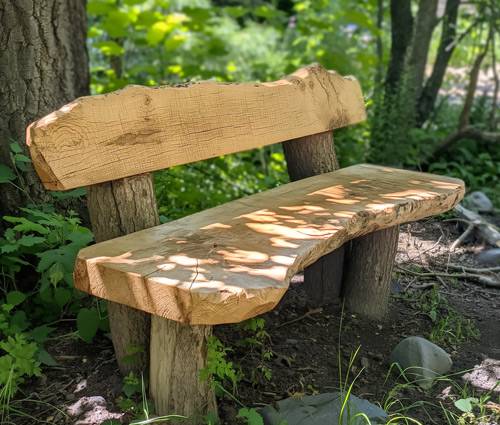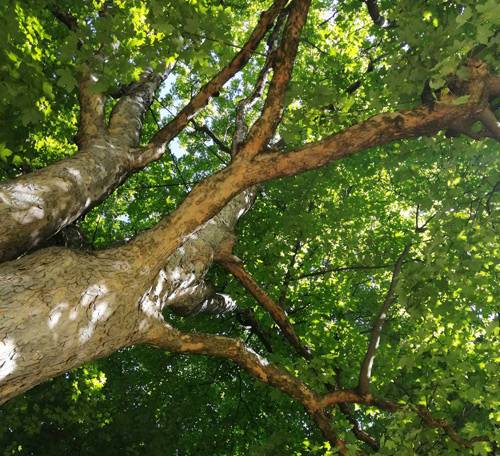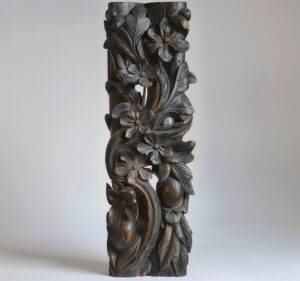Maple tree
The maple tree is known for its shade in summer and its fascinating foliage in autumn. Its wood is white and fine-pored, with a strong grain. The tree is robust and can grow up to 30 metres high. Maple wood is light, yet hard and abrasion-resistant, ideal for making handles and tools. Maple has natural antibacterial properties and is therefore often used for chopping boards and kitchen utensils. In Styrian inns, the table tops are often made of maple wood. It is also well suited for billiard cues and instrument making. Due to its vibrating properties, maple supports the sound of instruments.

The importance of maple wood in the furniture industry
Maple wood has a long history in furniture manufacturing and has become very popular due to its unique properties. It is a hardwood with a light colour and a fine grain that gives it an elegant look. Maple wood furniture is known for its durability and longevity.
Popular pieces of furniture made from maple wood include beds, wardrobes, tables and chairs. Due to its strength, maple wood is particularly suitable for structural elements such as table tops or chair legs.
Sustainable forestry: How maple wood is obtained in an environmentally friendly way
Sustainable forestry plays a crucial role in the extraction of wood resources such as maple wood. The use of sustainable practices ensures that forests are protected and preserved. This includes measures such as selective logging, reforestation and the protection of natural habitats.
There are also certification programmes for sustainable maple wood, which ensure that the wood comes from responsible sources. Such programmes ensure that forestry meets environmental and social standards.
There are many benefits to using sustainable maple wood. Not only does it reduce deforestation of tropical forests, it also helps to reduce CO₂ emissions. It also supports local markets and creates jobs in the timber industry.
Maple wood as an alternative to tropical wood
The use of tropical wood in the furniture industry has a serious impact on our environment. The deforestation of tropical rainforests not only jeopardises rare animal and plant species, but also contributes to deforestation and climate change.
Maple wood offers an environmentally friendly alternative to tropical wood products. It is a sustainable raw material with similar properties to teak or mahogany. By using maple wood furniture, we can help to stop the depletion of our precious rainforest resources.
Many furniture manufacturers have already recognised that maple wood is a sustainable alternative to tropical wood. They offer a variety of maple wood furniture that is both environmentally friendly and aesthetically pleasing.
The aesthetics of maple wood: natural beauty for every furnishing style
Maple wood is not only characterised by its sustainability, but also by its natural beauty. It has a light colour with a fine grain, which gives it a timeless and elegant look.
The aesthetics of maple wood furniture suit various interior design styles. Whether modern, rustic or classic — maple wood furniture can be a highlight in any room. It blends seamlessly into different colour palettes and decorating styles, adding warmth and character to any room.
Maple wood in the kitchen: robust and hygienic
Maple wood is not only suitable for furniture, but also for use in the kitchen. It is known for its durability and resistance to scratches and stains.
For this reason, it is often used for worktops or chopping boards. The smooth surface of the wood allows you to cut or work on food without worry.
In addition, maple wood has natural antibacterial properties that make it more hygienic than other materials such as plastic or stone.
Maple wood in the garden: durable and weather-resistant
Maple wood is also a good choice for outdoor use. It is durable and resistant to weather influences such as rain, sun and snow.
Unlike other types of wood, maple wood does not rot as quickly and is less susceptible to pest infestation. This makes it an ideal choice for garden furniture such as tables, chairs or benches.

Maple wood as a material: versatile and easy to work with
Maple wood is in great demand in various industries due to its versatility. It is not only used in furniture manufacturing, but also in the production of musical instruments, sports equipment and even aircraft parts.
The wood is easy to work and mould, making it ideal for the production of more complex designs. It can be carved, turned or bent to create unique shapes.
Maple wood compared to other types of wood: advantages and disadvantages at a glance
Compared to other popular types of wood, maple wood has both advantages and disadvantages. One major advantage is its sustainability — it can be obtained from responsible sources and contributes to the preservation of our forests.
Another advantage of maple wood furniture is its durability and longevity. It can last for years without needing much maintenance.
On the downside, maple wood can be more expensive than other types of wood. It also requires regular maintenance to maintain its beauty and durability.
When choosing maple wood for furniture or other applications, you should also consider the specific requirements and style of the room.

Conclusion
The use of sustainable maple wood in the furniture industry offers many advantages. Not only is it an environmentally friendly alternative to tropical wood, but it is also aesthetically pleasing and versatile.
By picking sustainable materials such as maple wood, we can reduce our ecological footprint and contribute to the conservation of our natural resources. It is up to all of us to make conscious choices and promote the use of sustainable materials in the furniture and other industries.
FAQs
What is maple wood?
Maple wood is the wood of maple trees. It is a hard and dense wood that is easy to work with and has a light colour.
Where is maple wood used?
Maple wood is used for a variety of applications including furniture, flooring, musical instruments, chopping boards and sports equipment.
How sustainable is maple wood?
Maple wood is a sustainable choice, as maple trees grow quickly and are widely available in many parts of the world. It is also a wood that is easy to work with, which means less energy is needed to produce maple wood products.
What are the benefits of maple wood?
Maple wood has many benefits, including its hardness, density and durability. It is also a very light-coloured wood, which is well suited for making furniture and other items that require a light colour. Maple wood also has a beautiful grain that makes it an aesthetically pleasing wood.
How do I care for maple wood?
To care for maple wood, you should clean and polish it regularly. Avoid exposing maple wood products to excessive moisture, as this can lead to warping and cracking. Do not use aggressive cleaning agents, either, as these can damage the wood.





